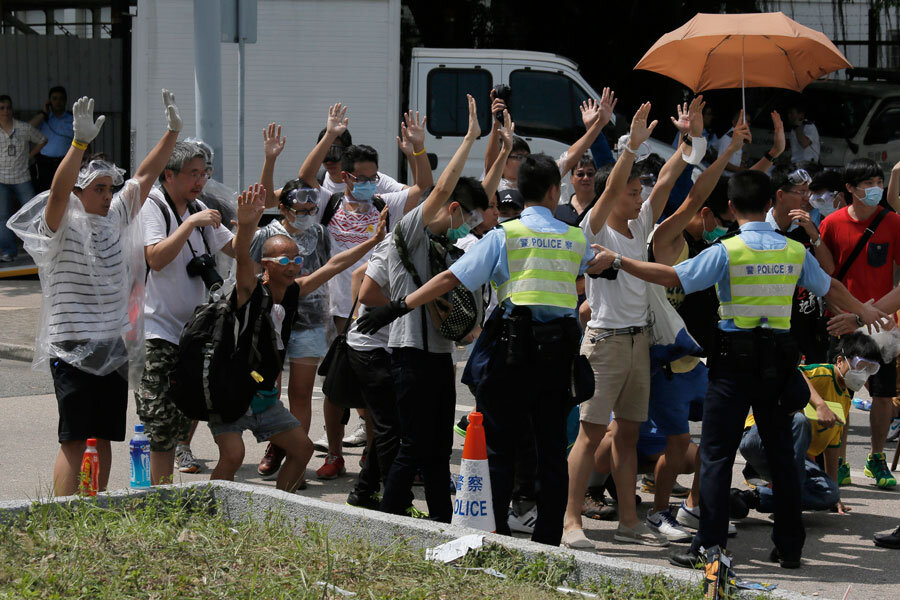How Ferguson's 'hands up' protest spread to Hong Kong ... sort of
Loading...
The symbolic “hands up, don’t shoot” gesture used by protesters in Ferguson, Mo., appears to have gone global this weekend as thousands of pro-democracy demonstrators in Hong Kong have been confronting aggressive police crackdowns with raised arms and open palms.
Calling their movement “Occupy Central” – also a direct echo of the Occupy Wall Street movement in the US – Chinese students in the sprawling Asian financial center continue to protest the Chinese government’s restrictions on candidates for upcoming local elections. They marched and set up camps, shutting down highways and shopping districts throughout downtown Hong Kong this weekend.
But when riot police began to shoot tear gas canisters to disperse the crowds on Sunday, marchers began to respond with the now-familiar “hands up” image from Ferguson, where a police officer shot and killed unarmed teen Michael Brown, who witnesses say had his hands in the air when he was shot.
Observers caution that so far there have been no direct confirmations that Hong Kong students are consciously emulating the Ferguson protests, however.
Instead, protest organizers in Hong Kong, a former British colony returned to China in 1997, had previously trained marchers to raise their hands with their palms face forward to indicate their peaceful intentions to authorities, reports Quartz. Organizers have officially dubbed their protest “Occupy Central with Love and Peace,” and had publicly announced the weekend protests months in advance.
Still, on Sunday some Ferguson protesters held signs of solidarity with their ostensible Chinese counterparts, some reading “Stay Strong” and “Hands Up! Don’t Shoot!” in both English and traditional Chinese characters.
Hundreds continue to gather in the St. Louis suburb nearly two months after Officer Darren Wilson shot and killed Mr. Brown, who is alleged to have assaulted the police officer during a street stop.
“Will you please show this to #MikeBrown's parents &let them know that he changed the WORLD!” tweeted one activist, as many in the US continue to connect the closely watched street protests and “hands up” gesture.
Indeed, as images of the Hong Kong protests are beamed throughout the globe through social media hashtags and photo sharing sites, many are beginning to see the defenseless gesture, especially in the haze of tear gas, as a symbol for nonviolent resistance.
On Monday morning, the Chinese government announced it had taken riot police off the streets as citizens “have mostly calmed down,” but they continue to urge protesters to disperse. They have also focused on social media, shutting down the photo-sharing application Instagram countrywide and blocking the hastag #OccupyCentral on Weibo, the Chinese version of Twitter, according to Britain’s The Daily Mail.
When Britain returned Hong Kong to China in 1997, the nations agreed that the former colony and financial center would have a “one country, two system” structure that allowed the densely-populated city to retain its capitalist economy, even as it rejoined mainland China’s communist regime.
But the Chinese government may allow only Beijing-approved candidates to run for the office of chief executive of the Hong Kong Special Administration Region, which operates with more autonomy than other regions in China.
“Hong Kong is in the midst of a passionate debate about our constitutional development,” wrote current chief executive C.Y. Leung in a CNN op-ed on Monday. “It's a debate we must have. But it's a debate that must be tempered with reason. Raw emotion – for or against the proposed political reform – will get us nowhere.”






